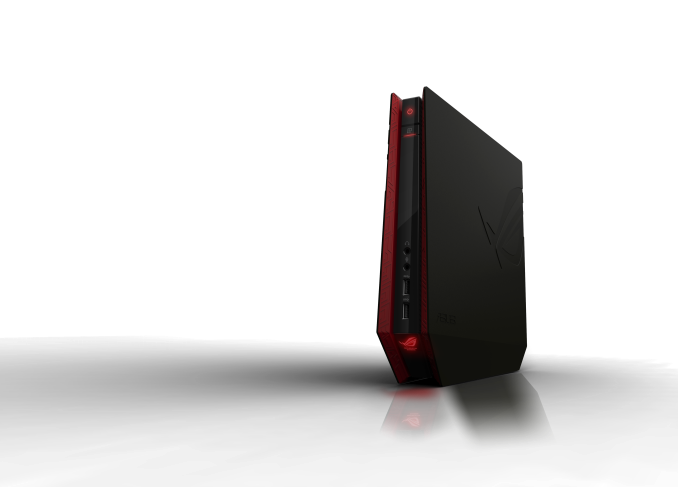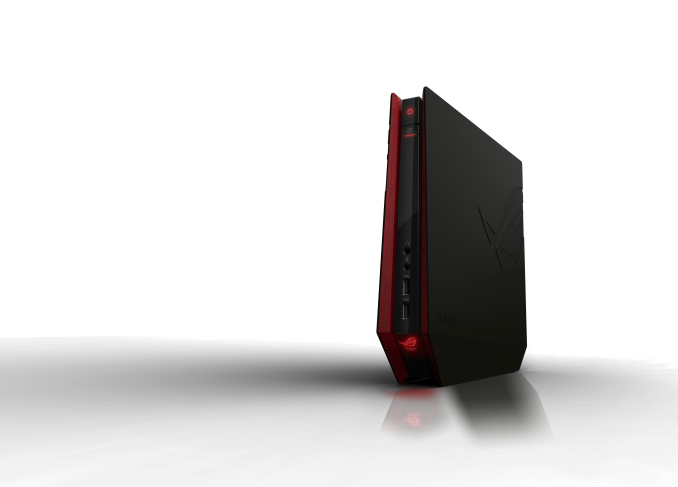ASUS Launches Two SFF ROG Gaming PCs: The G20 PC and the GR8 ‘Console’
by Ian Cutress on June 2, 2014 11:15 PM EST
Mini-PCs are currently one of the fastest growing desktop market segments, alongside all-in-ones and other small form factor (SFF) variants. While on the full desktop side most of the sales are still for ATX-sized devices, a lot of attention is put towards the growth of the mini-ITX market. To that extent, ASUS has designed and are bringing to market a pair of gaming PCs.
ROG G20 Gaming Desktop
The G20 Gaming Desktop, winner of a Best Choice Golden Award at Computex, uses a 12.5 liter chassis with no visible vents to support a Haswell Core i7 CPU with an NVIDIA GTX 780. The design uses ‘aggressive’ lines with a matte black finish in the red/black style of ASUS’ gaming range. The lighting on the outside of the case is split into three regions, each of which can be user controlled to 8 million different colors.
ASUS claim that the G20 offers efficient heat management and near-silent operation, giving 25dB at idle. I would assume that this, along with the note about having no visible vents, would suggest that ASUS has done away with CPU and GPU coolers and is using the case itself as a heatsink. This is not necessarily a new idea, but I cannot remember the last time I saw such a power hungry unit go along these lines. There is a small ‘hidden airflow tunnel’ to aid air-flow management (contains two ultra-quiet fans), which would make sense given that other elements in the system heat up as well.
The G20 is also being advertised with an Eco Energy Mode, which reduces the power usage of the system to around 20W. It is unclear if this is an idle power draw, or the system is reduced in clocks (to idle) for constant use similar to what some motherboards do. There is no word whether the motherboard and GPU are custom built for the system, however as more details are released we hope to get some kind of inclination.
Pricing will be dependent on what options are chosen, but ASUS expect it to be in the region of $800-$1700 with availability in Q3.
ROG GR8 Console Gaming PC
Text-speak aside (greeeeat), the GR8 equips an i7 with a GTX 750 Ti to provide a small form factor system designed for both gaming and streaming. Equipped with a Miracast receiver, the system will accept content from supported Android smartphones, tablets, Windows 8.1 PCs and WiDI 3.5+ devices.
The GR8 will initially be available in a Windows 8.1 configuration compatible with SteamOS, but a SteamOS configuration will be launched in alignment with Valve’s schedule. Behind the functionality we also have SupremeFX audio, optimized gigabit Ethernet, and upgradable storage/memory. The importance of such a device will be in the pricing, and users with wireless controllers might see this as a PC alternative to the console.
No pricing is yet available, though the GR8 is expected to launch in North America in Q3 as well.












12 Comments
View All Comments
Sttm - Monday, June 2, 2014 - link
What is the with the SteamOS fascination? I loaded it up on a HD and played around in it. It's about as useful an OS as the one that is on my BluRay player. Games and an awful full screen Web Browser. Why would you vastly limit what your PC can do for a console UI? It is madness.wolrah - Monday, June 2, 2014 - link
It's the same reason many of us run XBMCbuntu or similar distros that boot directly in to a HTPC frontend. We want a nice 10 foot UI built to act like an appliance. We have other PCs to use as full PCs, these are our lesser/spare/old PCs that we're using to fill a role. As long as they fill that role well nothing else matters.That said, SteamOS is still Debian underneath and is about the easiest thing in the world to get to a pretty standard desktop. You can do anything you could do on any other Debian derivative, it just boots to a gaming-focused UI by default. Nothing is being "vastly limited".
nathanddrews - Tuesday, June 3, 2014 - link
I played around with SteamOS for a bit, but lost interest quickly. You can still have a nice 10 foot UI with a regular PC. All my TVs and home theater are connected to fully capable Windows gaming machines that can either game on their own or Steam stream from my or my wife's main gaming rig. On top of that, you can load up Steam BPM, XBMC, Media Center, any browser of choice, or whatever else you want without being limited by an appliance. The appliance thing is great, but not if you need five appliances to do five different things.Ortanon - Tuesday, June 3, 2014 - link
The point you guys seem to be missing is that it's free.wintermute000 - Tuesday, June 3, 2014 - link
Free and unable to play 90% of the catalog vs 100 buck windows license and the full steam catalogue....curtwagner - Monday, December 8, 2014 - link
If you want a real gaming experience on your PC, I recommend on getting the CybertronPC Borg-Q high ranked based on consumer satisfaction (see http://www.topreport.org/desktop/ for example...)ZeDestructor - Tuesday, June 3, 2014 - link
I say bring on the streaming appliances!Just think of it: dump the big, heavy, dual-GPU, 6U rackmount in the basement and stream to all manner of thin clients around the house.
Hrel - Thursday, June 5, 2014 - link
IT's designed to offer the stability and ease of use of consoles on PC; for gaming mostly. Biggest barrier to people becoming PC gamers is how complex it is, troubleshooting, mods, even graphics settings are more than many are willing to do. They just want plug and play functionality, not work or configuration. Steam Box is seeking to address that problem.If people happen to start using them as media center's for the living room as well, all the better.
krazy_olie - Tuesday, June 3, 2014 - link
What I like about this is that it's a pre-built machine that uses that to it's advantage. It's borrowing from the Mac Pro.Anonymous Blowhard - Tuesday, June 3, 2014 - link
> GR8 equips an i7 with a GTX 750 TiWell, there goes all hope of it being reasonably priced. Hopefully they'll have an i5 or i3 version in the works, as an i7 is just a silly degree of overkill. I'd rather an i3 and either pocket the difference or ask them to stick an mSATA/M.2 SSD in there for caching.